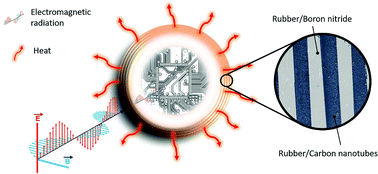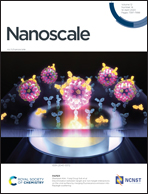An anisotropic layer-by-layer carbon nanotube/boron nitride/rubber composite and its application in electromagnetic shielding†
Abstract
Multifunctional polymer composites with anisotropic properties are attracting interest as they fulfil the growing demand of multitasking materials. In this work, anisotropic polymer composites have been fabricated by combining the layer-by-layer (LBL) filtration method with the alternative assembling of carbon nanotubes (CNTs) and hexagonal boron nitride flakes (hBN) on natural rubber latex particles (NR). The layered composites exhibit anisotropic thermal and electrical conductivities, which are tailored through the layer formulations. The best composite consists of four layers of NR modified with 8 phr (parts per Hundred Rubber) CNTs (∼7.4 wt%) and four alternate layers with 12 phr hBN (∼10.7 wt%). The composites exhibit an electromagnetic interference (EMI) shielding effectiveness of 22.41 ± 0.14 dB mm−1 at 10.3 GHz and a thermal conductivity equal to 0.25 W m−1 K−1. Furthermore, when the layered composite is used as an electrical thermal heater the surface reaches a stable temperature of ∼103 °C in approx. 2 min, with an input bias of 2.5 V.

- This article is part of the themed collection: Editor’s Choice: Controlling anisotropy in nanomaterials


 Please wait while we load your content...
Please wait while we load your content...